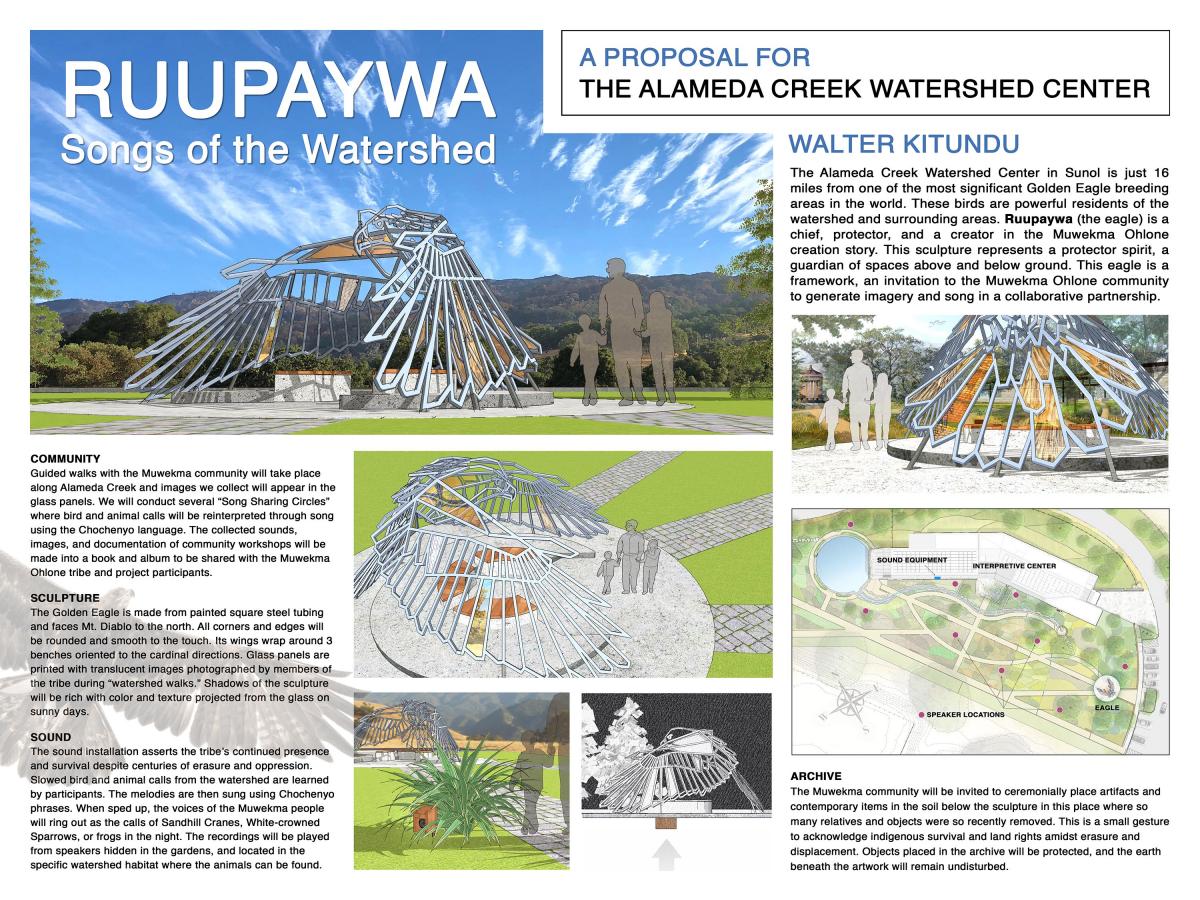 This project includes a sculpture, sound installation, and archive. It begins at the threshold of mixed evergreen and oak savanna and winds its way to the edge of the bay. It pays tribute to the Muwekma Ohlone People and recognizes both their history and their continued presence and power. Ruupaywa (the eagle) is a chief, a protector, and a creator in the Muwekma Ohlone creation story. This sculpture represents a protector spirit, a guardian of spaces above and below ground. It is meant as a vessel, a sheltering place for reflection, remembrance, and visioning.
This project includes a sculpture, sound installation, and archive. It begins at the threshold of mixed evergreen and oak savanna and winds its way to the edge of the bay. It pays tribute to the Muwekma Ohlone People and recognizes both their history and their continued presence and power. Ruupaywa (the eagle) is a chief, a protector, and a creator in the Muwekma Ohlone creation story. This sculpture represents a protector spirit, a guardian of spaces above and below ground. It is meant as a vessel, a sheltering place for reflection, remembrance, and visioning.
The Alameda Creek Watershed Center in Sunol is only 16 miles from one of the most significant Golden Eagle breeding areas in the world. These birds are powerful residents of the watershed and surrounding areas. This eagle sculpture is a framework, an invitation to the Muwekma Ohlone community to generate imagery and song in a collaborative partnership. Open areas in the wings and tail will be filled with images gathered collectively on “Watershed Walks.” The sound component will be composed entirely from voices from the tribe translated into the songs and calls of the watershed. And finally, the artwork offers an invitation to consider archiving artifacts in the earth at this site, under the protection of the guardian eagle.
Sculpture
The Golden Eagle is made from welded 2” square steel tubing, sandblasted and painted to withstand the harshest elements. It floats in a protective posture facing Mt. Diablo to the north, its wings wrapped around 3 benches oriented according to the cardinal directions. The 3500 lb structure is composed of 5 assemblies bolted together at their seams and resting on 9 plates anchored in the concrete. The intersecting steel members create a lattice that ensures the structure is strong enough to support itself and endure wind loads or any unanticipated loads or impacts. All corners and edges will be rounded and smooth to the touch.
Several openings in the sculptural framework house 9/16” waterjet cut laminated glass panels printed with translucent imagery taken by “watershed walk” participants and selected through consultation with the tribe. These images will be printed onto the laminate of DuPont Sentryglas® by Pulp Studios. The steel structure will have tabs welded in place and engineered to support stainless steel standoffs onto which the glass will be mounted as part of installation on site (see “glass mounting” PDF attached).
The vivid images will populate the area with color and texture through reflected light and cast shadows. Tule reed textures printed on tail panels will evoke the historic shelters constructed by Muwekma Ohlone people.
It will be possible to face any of the four cardinal directions while seated on the 3 wood benches under the protection of the eagle. The raised area surrounding the benches serves to delineate the space while also serving as an indicator of the sculpture’s presence to visually impaired persons who may be navigating with a cane.
Sound
The sound installation is a response to a desire communicated by the tribe to assert their continued presence and survival despite centuries of erasure and oppression. It is an invitation to members of the Muwekma community to select and learn the songs of birds and animals in a unique way. The technique is inspired by artist Marcus Coates’ brilliant work entitled “Dawn Chorus.”
We will slow the calls of the eagle, the hawk, the hummingbird, the coyote, the Acorn Woodpecker, the Bobcat, and many other watershed species until they enter the human vocal range. Then, singing the melodies in Chochenyo, each person will learn and replicate the sounds of the slowed animal calls. This very forgiving process can be done in very short, easy to learn sections. The phrases sung will be affirmations and declarations chosen through conversations with the Muwekma tribe. Phrases could include “Makkin mak hayyanakše… we are fighters,” and “mak waara, mak hinnan – our bodies, our souls.”
The resulting recordings are then sped up to their original tempos and the voices of the Muwekma people will ring out as the calls of Sandhill Cranes, White-crowned Sparrows, or frogs in the night.
The recordings will be played through weatherproof speakers situated in 8-10 locations throughout the gardens, their positions matching their preferred habitats within the watershed. They will be housed in small cedar boxes low to the ground to protect them from the elements and to disguise and obscure the source of the calls. The boxes will disappear into the vegetation as the wood weathers and will not play a visual role.
The sound installation can be an audio treasure hunt for those wanting to learn about the wildlife of the watershed, but for the tribe it is offered as a repository of language and a document of multigenerational community expression.
The installation will also be quite subtle and available to those who are attentive and patient. Any sound work intending to last 25 years must be artfully implemented. The work will be an element of the garden environment outside the walls of the Watershed Center and tuned to complement the existing soundscape.
The Archive
Below Ruupaywa the eagle, between the benches, rests an archive. Once the sculpture is in place and before any official opening, members of the tribe will be invited to ceremonially place artifacts and contemporary items, in the soil below. There would be an opening in the concrete to a small chamber in the earth below. A non-public, closing ceremony could be held for invited members to place things into the earth - in this place where so many relatives and objects were so recently removed. Whether this ceremony and archive occurs is entirely up to the Muwekma people and this is merely an invitation to share the ground beneath the sculpture. At the close of the ceremony I suggest the soil could be replaced and the central circle of the work sealed permanently with concrete matching the surrounding work.
This is a small gesture to acknowledge indigenous survival and land rights amidst erasure and displacement. Objects placed in the archive will be protected, and the earth beneath the artwork will remain undisturbed.
I would ask that the archive although present in the proposal and board, not be listed in any future public documentation (should this proposal be accepted) without the express consent of the tribe.
Community
This public artwork is a frame for material generated through engagement with the Muwekma people. I will convene a conversation to discuss how the artwork can best fulfill its role in honoring their past while looking to the future. This gathering will address language use, significant visual symbols, the role of youth, the archive, my role as artist and outsider, and any site specific concerns.
Guided “Watershed Walks” will take place in at least 2 locations along Alameda Creek. Listening exercises will be shared. During these walks cameras will be distributed and we will pay careful attention to textures and imagery and sound. Participants will contribute pictures taken on the walk to a photo library from which we will carefully choose some of the final images for the glass panels. We will also conduct several “Song Sharing Circles” where bird and animal calls will be slowed, reinterpreted, and taught as sung phrases using the Chochenyo language. When agreed, we will record these songs in a professional local recording studio for inclusion in the sound installation. The collected songs, images, and documentation of workshops will be compiled into a book and audio tracks to be shared with all participants. Food will be provided for all workshops along with time for reflection and consideration of the day’s events.
View a larger image of the proposal.
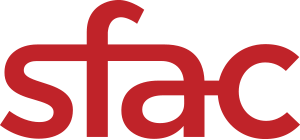
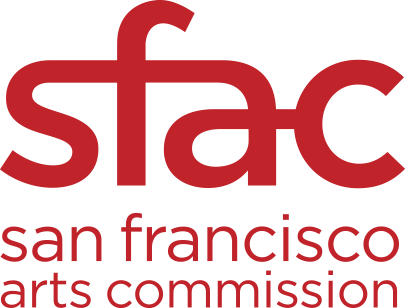

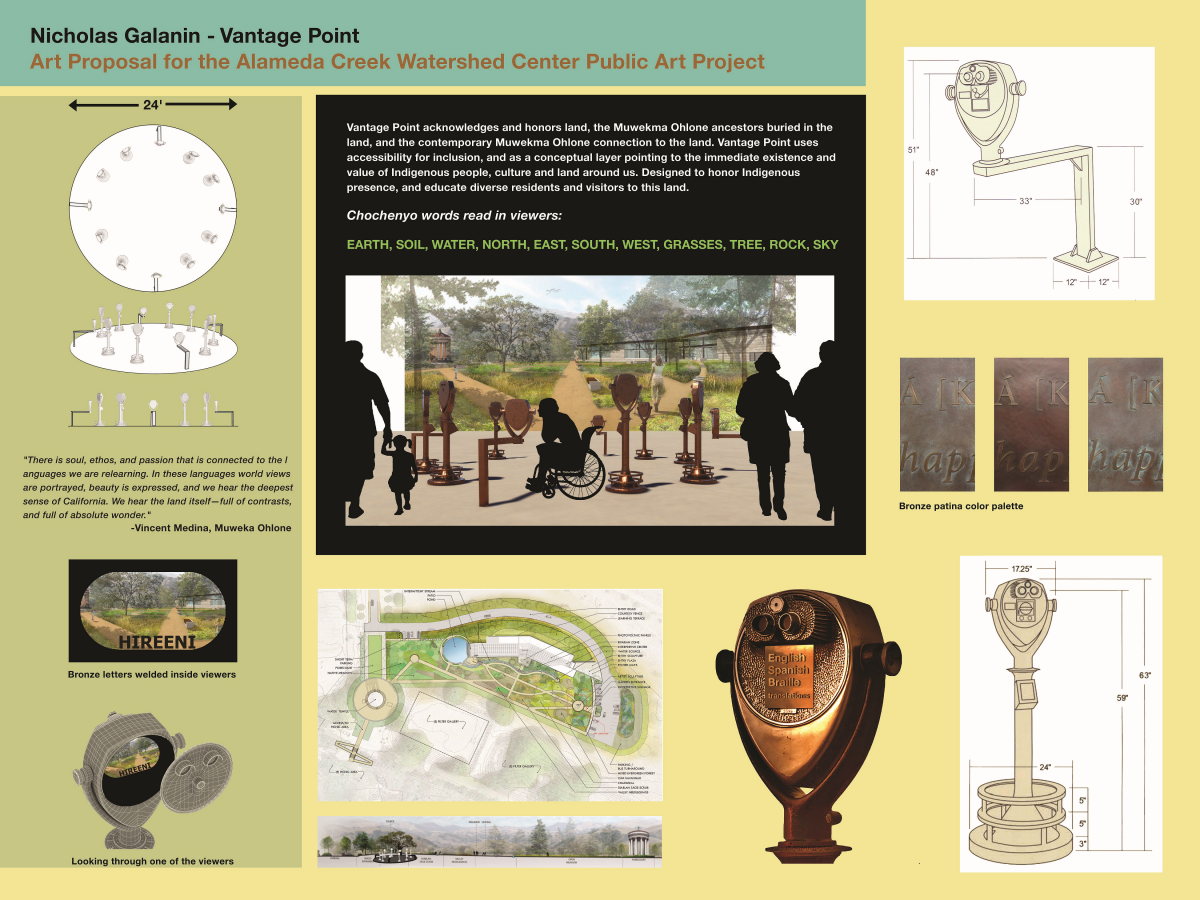 Vantage Point conceptually foregrounds Muwekma Ohlone people and the connection of Indigenous people to land. Chochenyo words in silhouette within bronze tower viewers make Indigenous presence and knowledge part of the view of land. The work provides visitors with a vantage point not based on elevation or distance; a reminder of the immediate presence of Indigenous people, and value of the land under our feet .
Vantage Point conceptually foregrounds Muwekma Ohlone people and the connection of Indigenous people to land. Chochenyo words in silhouette within bronze tower viewers make Indigenous presence and knowledge part of the view of land. The work provides visitors with a vantage point not based on elevation or distance; a reminder of the immediate presence of Indigenous people, and value of the land under our feet . This project includes a sculpture, sound installation, and archive. It begins at the threshold of mixed evergreen and oak savanna and winds its way to the edge of the bay. It pays tribute to the Muwekma Ohlone People and recognizes both their history and their continued presence and power. Ruupaywa (the eagle) is a chief, a protector, and a creator in the Muwekma Ohlone creation story. This sculpture represents a protector spirit, a guardian of spaces above and below ground. It is meant as a vessel, a sheltering place for reflection, remembrance, and visioning.
This project includes a sculpture, sound installation, and archive. It begins at the threshold of mixed evergreen and oak savanna and winds its way to the edge of the bay. It pays tribute to the Muwekma Ohlone People and recognizes both their history and their continued presence and power. Ruupaywa (the eagle) is a chief, a protector, and a creator in the Muwekma Ohlone creation story. This sculpture represents a protector spirit, a guardian of spaces above and below ground. It is meant as a vessel, a sheltering place for reflection, remembrance, and visioning.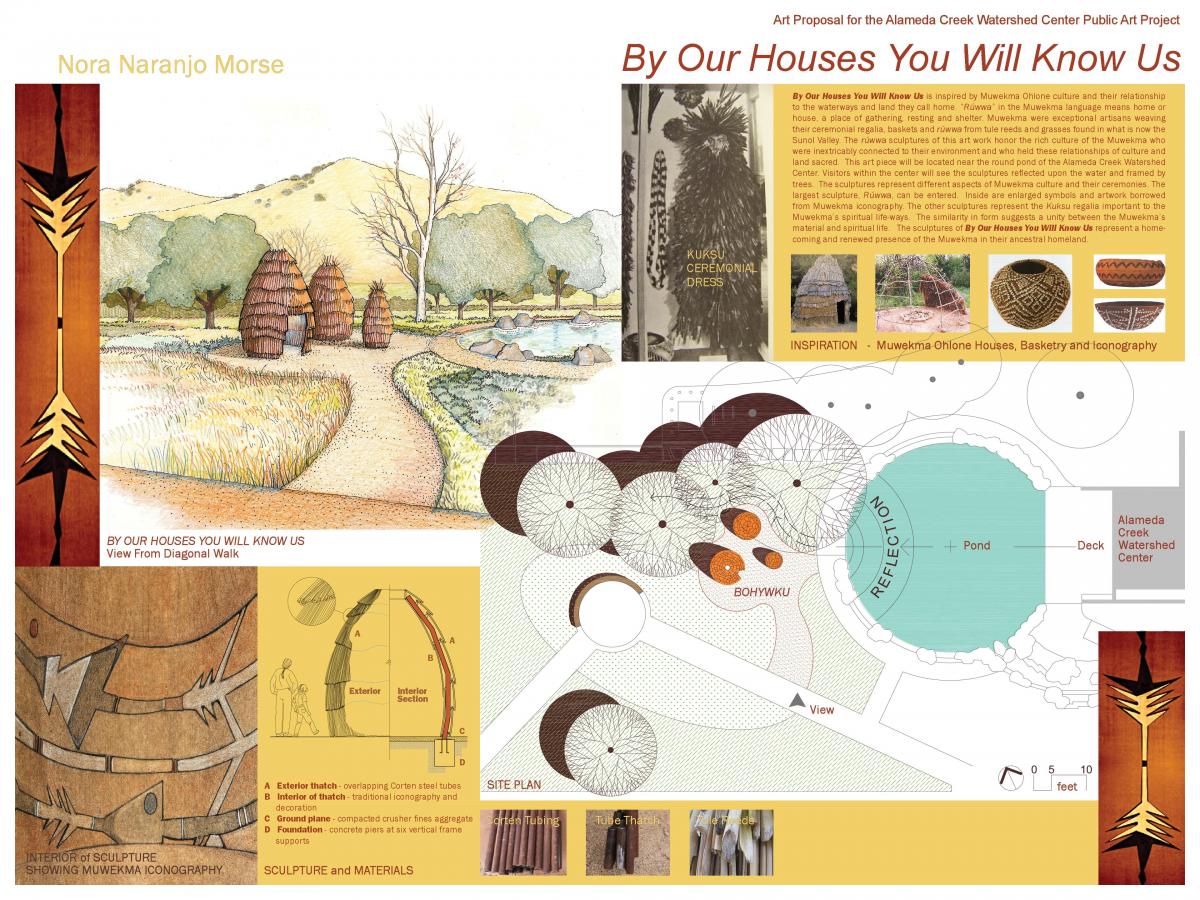 At the turn of the century a Kickapoo elder was asked to describe his culture and people; he stated simply, “By our houses you will know us.”
At the turn of the century a Kickapoo elder was asked to describe his culture and people; he stated simply, “By our houses you will know us.”
Opportunity For Public Comment
Please take a few minutes to review these artwork proposals and provide feedback on the public comment forms below. Public comments will be considered by the Review Panel as part of the Final Artist Review meeting where the Panel will recommend one proposal for implementation. Please note that public comments do not constitute a vote.
The Final Artist Review Panel will take place Thursday, February 13, 2020, 1:00–5:00 p.m. at 401 Van Ness Avenue, Room 302. All Artist Review Panel meetings are open to the public. An agenda for the meeting will be posted 72 hours in advance of the meeting on SFAC’s website under the Public Meeting section: www.sfartscommission.org
The proposals are available online at www.sfartscommission.org/calendar, in the Public Art Proposal Display section. Comments may be emailed to sfacpublicartcomment@sfgov.org or hand delivered/mailed to 401 Van Ness Avenue, Room 325 by Wednesday, February 5, 2020 at 5:00 p.m.